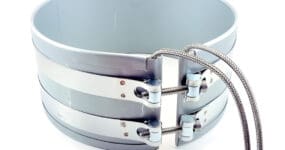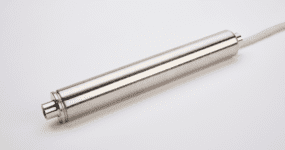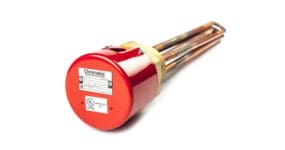
The Best Industrial Heaters for Plastic Processing
Whether you run an injection molding, extrusion, or blow molding operation, uniform temperature distribution is essential for preventing defects like warping and sink marks. Electric heaters are one of the best ways to not only ensure uniform heating but also ensure precise temperature control when working with different polymers.
In this article, we’ll highlight the three best types of industrial electric heaters to use for plastics processing: band, cartridge, and immersion, as well as factors to consider when making your selection.
Band Heaters

Band heaters are commonly used on injection mold and extruder barrels. Their “band” design allows them to wrap around the exterior of the object being heated, resulting in superior thermal conductivity that ensures efficient heat transfer and distribution.
Band heaters are most often categorized by their insulation material (mica, ceramic, mineral, or fiberglass). The type of insulation material really depends on temperature requirements. Mineral-insulated band heaters are generally used in high-temperature applications (up to 1,400 degrees Fahrenheit) because their magnesium oxide-based insulation provides excellent heat conductivity and electrical insulation properties.
Beyond insulation material, band heaters can also be categorized by size, installation method, mounting, sheathing, and operational characteristics.
Cartridge Heaters

Cartridge heaters, also called rod heaters or insertion heaters, are tubed-shaped and designed for insertion into holes drilled into dies, molds, or other objects. While band heaters transfer heat from outside the target object, cartridge heaters provide local and precise heat from the inside.
Cartridge heaters are available in several diameters, lengths, and designs, including standard insertion, split sheath, custom, and high density.
Standard heaters have a coil wound around a ceramic core that’s surrounded by magnesium oxide insulation and then encased in a metal sheath. They are typically not recommended for high-precision or high-temperature applications.
Split sheath, as the name suggests, has a longitudinal split in the sheath. This design can handle looser hole set, higher temperatures and watt densities than standard models.
Immersion Heaters

As you can guess, immersion heaters are submerged directly in heat transfer fluids such as water or oil that are being heated, ensuring that all the heat generated transfers directly to the heated substance. When the tank and heater are properly sized for the required flow, immersion heaters offer high energy efficiency.
In plastics processing, immersion heaters are commonly submerged in tanks. Depending on the process configuration, screw plug, flanged, or over-the-side immersion heaters may apply. Flanged immersion heaters are standard for applications using high kilowatts.
Factors to Consider When Selecting a Heater
Like all industrial processes, engineers must consider various factors when designing or modifying a plastics processing system. Each system involves trade-offs to achieve the optimal combination of quality control, speed, energy efficiency, operational flexibility, and maintenance requirements. Heaters play a crucial role in each issue, so selecting the correct heater type and its detailed specification is critical and has long-term implications for your operation.
Process & Material Compatibility
Fitting the correct heater type to your operation is important because it affects quality and energy efficiency. Band heaters are commonly used to heat barrels/heads in plastic extrusion, and injection molding. In contrast, cartridge heaters, which can handle higher temperatures and resist vibration, are frequently used in tooling related to injection molding, blow molding, and extrusion molding applications.
Temperature Range
While many factors come into play when choosing which heater will work best for a specific application, mica band heaters are regularly used for lower-temperature plastics due to their ability to handle moderate heat without overheating. Ceramic band heaters are common with medium-temperature plastics because they can handle these temperatures while maintaining good heat distribution.
Cartridge heaters designed for high temperatures are standard in tooling applications that require high heat, like extrusion processes.
Power
Plastics processing occurs at various temperatures and, therefore, power requirements. The heater type you choose for a particular application must fit the other system elements. Still, those with high power demands often look toward high-density cartridge heaters, particularly when high power is needed within a confined space. Their use minimizes cold spots and ensures effective heat distribution at temperatures up to 1,400 degrees Fahrenheit.
Size & Configuration
The different heater types are optimized for use in varying applications, so they are constructed in different shapes and sizes using various materials. Most band heaters are available for barrels ranging from one to four inches in diameter, yet others are substantially larger, wrapping around barrels or vats filled with plastic. Most band heaters are round, but rectangular band heaters are also used for specific operations.
Since cartridge heaters are inserted into bore holes, there is limited variation in their circumference, but they can vary substantially in their length. Split sheath cartridge heaters are configured so they expand when heated to maximize the contact and heat transfer.
Immersion heaters have screw plug, flanged, and over-the-side variations that offer different benefits, depending on the insertion method.
Environment
Lastly, heating elements may be exposed to environmental conditions that can cause them to deteriorate. High humidity, temperature changes, and exposure to caustic elements can lead to pitting and other forms of corrosion. So, it’s important to consider the material the heater is constructed from. Stainless steel is definitely the top choice for corrosion resistance, but it is also an expensive material. In some cases, special coatings might be the most cost-effective option.
Get Help From a Hi-Watt Application Specialist
Hi-Watt is a leading distributor of thermal control products in Michigan, including industrial heaters. We offer a wide range of products, both stock and custom, for applications ranging from plastics processing to metalworking.
Visit our website to explore some of our available products, or contact us today to speak with one of our application specialists who can help you find the right solution.
